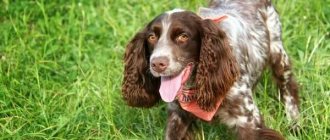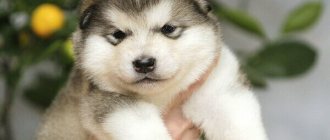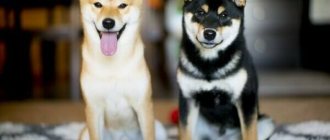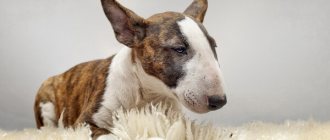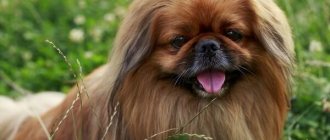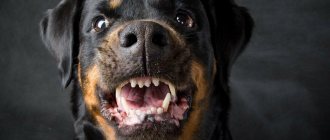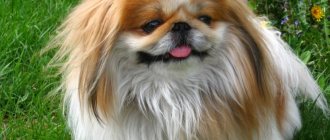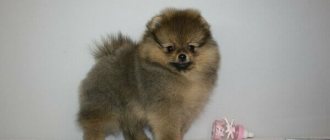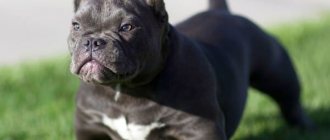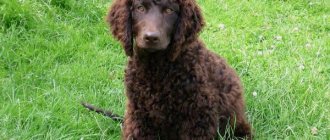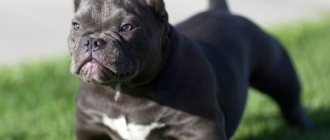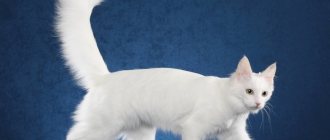It's not often you see a pure white husky.
Such dogs are highly valued among professional breeders and often become winners of exhibitions.
But the white husky is also incredibly good as a pet - it has a friendly and playful disposition.
His fur, sparkling in the sun's rays like freshly fallen snow, will invariably attract attention to such a pet on walks.
A white husky with brown or blue eyes will never go unnoticed at exhibitions - experts will definitely pay attention to a dog of this color and will probably appreciate it highly.
Origin story and what it looks like in the photo
White huskies owe their appearance to the harsh climate of the north of East Asia and to the tribes that in ancient times lived on the territory of modern Chukotka.
One day, when these people needed to move to new territories rich in game, they bred a strong, hardy and unpretentious dog, which later became known as the Chukchi sled dog.
Until now, representatives of this breed, already recognized by the RKF, continue to be bred in Chukotka.
It was from them that Siberian Huskies inherited a variety of colors, including white and coat colors derived from it.
Sled dogs were so popular in the north of the Far Eastern part of Russia and were bred by local tribes in such large numbers that in the old days these lands were called “the country of dogs.”.
In the 17th and 18th centuries, when the fur trade acquired particular importance for the Russian Empire, these territories began to be actively developed by pioneers, and, later, by the first settlers.
This contributed to the development of sled dog breeding, and for the first time the world learned about the existence of dogs that can be used to transport people or cargo.
In the early 20th century, sled dogs were introduced to Alaska, where they soon became popular as working dogs and racing dogs . The recognition of this breed became the beginning of exhibition breeding and contributed to the fact that the white color began to be highly valued.
Are there other varieties?
There is only one variety of this breed - Siberian Husky . These are the dogs that can be seen on the street, at exhibitions, in films and in photographs popular on the Internet.
They are also used as sports and riding vehicles.
Currently, there are few working huskies left, since dogs of show lines, which are in greatest demand among buyers, are mainly bred.
As for racing dogs, practice shows that husky mixes with other similar breeds show better results and, most importantly, are more versatile than purebreds.
Siberian Huskies have also gained popularity as pets and companions. This was facilitated by their friendly disposition, lack of aggression towards humans and love for children. Also, a significant role in the popularization of the breed was played by the fact that huskies are one of the few breeds whose representatives have blue eyes and even heterochromia .
Touched by the appearance of these dogs, people sometimes lose sight of the fact that huskies are not suitable for guarding and that they make poor hunting assistants.
IMPORTANT!
Before getting such a pet, you need to study the behavior, temperament and character of these dogs, and you should not listen to what people who are ignorant of dog breeding say about Siberian Huskies.
Now let's talk about dogs that, while not being subspecies of this breed, nevertheless have similarities and often common origins with the Siberian Husky.
Sakhalinskaya
Like Siberian Huskies, they are one of the oldest sled breeds, bred in the Amur region and Sakhalin.
The creators of this breed were people belonging to the Nivkh people, who were previously called Gilyaks in Rus'. Therefore, Sakhalin Huskies are also called Gilyak Laikas, and the Japanese name for this breed is Karafuto-ken, which means “Sakhalin dog”.
Sakhalin Laikas are famous for their endurance, high intelligence and devotion to their owner; they are calm, calm and fearless. It is not without reason that local residents used them not only as a sled breed, but also for hunting sea animals and even baiting bears. Their distinctive external features are a strong skeleton of a rather elongated format with well-developed muscles, strong paws adapted to move through snowy and rough terrain, and a rough-shaped head.
The tail of Sakhalin Huskies can be lowered in the form of a log or raised above the back and sickle-shaped, and in ancient times the Nivkhs often cut off the tails of their dogs at an early age. The most typical colors are black, white, grey, red or brindle.
Popular as excellent sled dogs in the late 19th and early 20th centuries, Sakhalin Huskies are now considered an extremely rare and even endangered breed.
Despite its name, this breed is not related to the Siberian Husky, but, apparently, to the Akita Inu.
Alaskan
This dog, not yet officially recognized by any canine federation, is the result of crossing several dog breeds, including Siberian Husky, Malamute, Border Collie, hounds, pointers and even German shepherd.
Alaskan Huskies were bred as a universal racing and sledding breed, and having inherited the best qualities of their ancestors, they are distinguished by strength, endurance and excellent speed qualities. It can be said that most races are won by teams consisting of these dogs, the cost of which can reach $10,000.
Externally, Alaskan Huskies do not look as impressive and elegant as Siberian Huskies: they are leaner and longer-legged and, in general, seem more mongrel-like. The use of many other breeds in their breeding has led to the fact that these dogs are very different types and differ both in body features and color, as well as in size.
Working sledded Alaskan huskies are larger and more massive than racing ones, for which speed qualities are of particular importance, rather than strength and power.
Typically, these dogs weigh from 16 to 27 kg.
By nature, Alaskans are friendly and affectionate with their owners, they get along well with other dogs, but, like Siberian huskies, they can be prone to running away and wandering.
Mackenzie river
A sled breed bred in Alaska, not officially recognized in any country in the world.
These are quite large animals, their height ranges from 66 to 74 cm, and their weight ranges from 29 to 47 kg. They have a powerful, but not coarse or squat bone structure, well-developed muscles and relatively long legs, allowing Mackenzie River Huskies to move through deep snow and, at the same time, carry fairly heavy loads.
These dogs are characterized by a long and thick double-layer coat, and the most common colors are various shades of black, white, gray, sable, brown, red and fawn.
Mackenzie River Huskies were developed by crossing sled dogs native to the Arctic and subarctic regions of Canada and Alaska with larger breeds such as Newfoundlands and St. Bernards.
Marriage or breed?
White coloring is considered acceptable for a husky, but only if it also has black or brown pigmentation.
Expert opinion
Kozhevin Semyon Kirillovich
Expert dog handler.
“The white color in this breed was not very popular before, since it was more difficult for mushers to see white dogs during a blizzard in the snow than animals with a darker color. Only the recognition of the Siberian Husky as a separate breed contributed to the fact that pure white dogs began to be in demand and highly valued. Currently, this coat color is still considered rare, and therefore such puppies, especially if they have blue eyes, can be quite expensive. However, it should be noted that the white husky will never go unnoticed: on the street, at a party, and even in the show rings, it will certainly be the center of attention.”
Main characteristics
- balanced proportions;
- the average size;
- free and easy movements;
- neat head shape;
- moderate backbone (skeleton);
- appropriate length and condition of the coat;
- tail of correct length and feathering;
- friendly character.
Similar articles:
- Keeping a Siberian Husky in an apartment or private house
- Character of the Siberian Husky
- Why do huskies have different eyes?
- Siberian Husky colors
- Longhaired Husky
Character traits
The White Husky is a friendly, playful and cheerful dog who usually becomes very attached to his owners and simply adores children. These are excellent companion dogs, and white huskies can achieve excellent results in sports.
These dogs are characterized by such qualities as intelligence, intelligence and the ability to make decisions independently if the owner cannot do this for some reason .
Contrary to popular belief that huskies are difficult to train, they are excellent at learning new commands.
NOTE!
These dogs are characterized by such qualities as independence and independent disposition, which sometimes turn into self-will.
In addition, huskies have a tendency to run away and wander, and if they stay in an apartment all day, they can howl from boredom or chew furniture.
These dogs are as friendly to strangers as they are to their owners, which creates some difficulties when walking with them and makes them unsuitable as guards.
A white husky may be aggressive towards other animals, especially small rodents or birds, and try to grab them.
Historical reference
Representatives of this breed appeared several thousand years ago. They were brought out by the Chukchi, who inhabited the territory of North-Eastern Siberia. Since these people did not write down their history and kept themselves apart from other peoples, more precise dates for the appearance of the first huskies could not be established. It is possible that the purity of the breed was preserved due to the fact that the Chukchi lived far from civilization.
In the first half of the 20th century, American gold miners who participated in dog sled racing acquired several dozen dogs they liked. This is how the first huskies came to the USA and helped save the breed. These animals were brought to Russia from the Czech Republic and Belgium. This only happened in 1995. Since foreign breeders paid more attention to the exterior rather than driving performance, today these friendly dogs do an excellent job as a companion and just a pet.
Advantages and disadvantages
pros:
- Beautiful and unusual appearance.
- Endurance and unpretentiousness.
- They can live both in rural areas and in city apartments.
- Friendly attitude towards people.
- Intelligence and intelligence.
- Ability to independently find solutions.
- Playfulness and love for children.
- Devotion to the owner.
- Uncomplicated daily grooming.
Minuses:
- Tendency to howl, making tunnels, running away and wandering.
- Staying in the apartment all day can damage furniture or other things.
- They need long active walks, as well as great physical activity.
- Very cunning and at the same time mischievous.
- Sometimes they are self-willed and stubborn.
- They can be aggressive towards small animals.
- They are overly trusting of strangers and are not suitable for the role of guard dogs.
Dimensions, weight and other distinctive features
| Options | Description |
| Dimensions | Males - 53.5-60 cm Bitches - 50.5-56 cm |
| Weight | Males - from 20.5 to 28 kg Bitches - from 15.5 to 23 kg |
| Body Format | Slightly stretched, but close to square: the length of the body exceeds the height at the withers by 1-3 cm. |
| Head | Wider in the forehead and somewhat narrower towards the muzzle. |
| Ears | Triangular, standing, medium in size. |
| Eyes | Set slightly obliquely, almond-shaped. Eye color can be brownish in various shades, as well as blue or light blue. Heterochromia is also considered acceptable. |
| Nose | The nose of white huskies can be black, brown or almost flesh-colored, and “snow” pigmentation is also possible. |
| Neck | Medium in length, not too massive, but at the same time strong and muscular. |
| Rib cage | Quite deep and wide. |
| Limbs | The front ones should be parallel, level, and moderately wide. The hind legs have well-developed muscles. |
| Tail | It is shaped like a fox's tail. When at rest, the husky keeps it lowered, but when excited, the tail rises above the back in the shape of a sickle. |
| Wool | Double layer, medium length. It consists of dense, harsh guard hairs that adhere to the body and soft, thick undercoat. |
Non-standard coat and eye colors
The standard for this breed dated January 24, 2000 No. 270 does not contain information regarding the shade of the iris and coat color, which could be considered defects. These animals' eyes can be any color. Contrary to erroneous belief, heterochromia is not a disqualifying defect. As for color, various options are acceptable - from snow-white to completely black.
Share with friends!
Husky shades of white
- White . With this color, the dog should not have a single mark of a different color, but the nose, edges of the eyelids and lips must have black or brown pigmentation.
- Red and white . Against the main background of a reddish, fawn or copper shade, there is a subclass: lightening of the coat to white on the head, muzzle, neck, chest, lower part of the body, lower legs and tail.
- Brown and white . The main background is brown from dark copper to a shade of dark chocolate, with this color the dog also has a white undercoat.
- Gray-white . On the main color of any of the shades of gray, from light silver to graphite, there is a white undercoat, and, often, markings in the form of a mask or glasses on the face and forehead.
- Black and white . On a black background there is a white undercoat and, often, markings on the face and forehead in the form of a mask and glasses or a trefoil.
- Piebald . Markings of red, grey, brown or black are scattered on the main white background.
- Splash . This color looks as if a black, grey, red or brown mantle had been thrown over a white dog. Typically, a husky with this coloring has a white collar, as well as a blaze on the forehead and muzzle.
- Isabella . The tips of the white coat are darkened to a cream or pale red tint.
- Silver . The tips of the white hairs are darkened to gray or silver.
The breed standard does not prohibit merle coloring in huskies, however, not all experts recognize it, believing that such a coat color is atypical for sled dogs.
Common, but no less beloved
Another transitional stage between white and black is gray wool, which looks no less impressive than all other options. Although this coloring is not considered rare for dogs representing the Husky breed, there are still hunters for it.
The undercoat is mainly silver, tinged with beige and cream. The wool itself is traditionally grey. Regarding the contours around the eyes and the coloring of the nose, these parts can be exclusively black.
Life expectancy and what diseases are they susceptible to?
The average lifespan of white huskies is 12-15 years, and they may be predisposed to the following diseases :
- Degenerative myelopathy.
- Glaucoma.
- Cataract.
- Eversion or inversion of the eyelid.
- Dermatitis.
- Cardiovascular diseases.
- Diseases of the genitourinary area, more common in males than in females.
- Respiratory diseases that can develop in racing dogs.
White Huskies can also be susceptible to food allergies, and most often, they develop them due to improperly selected food..
Different iris color
The breed standard is not limited to just the blue tint of the iris. You can often find Huskies with deep brown or black looks. As a rule, such individuals have a more saturated coat color, for example, black with splashes of white. Huskies with warm brown coats often have reddish-amber eyes. Sometimes there are representatives of the breed with olive-colored eyes.
Despite the fact that many strive to become the owner of a dog with blue eyes, brown-eyed individuals are considered more practical. The sky-hued iris is more sensitive to light. In conditions of frequent and heavy snowfalls, you can notice that blue-eyed huskies are constantly squinting their eyes. In addition, it is believed that individuals with a dark look are more resistant to disease.
Basic rules of care
The coat of such a pet needs to be combed twice a week, and during shedding - daily, trying to remove the falling out undercoat as best as possible.
There is often no need to bathe white huskies, since they are neat animals, and their coat has the ability to self-clean . Therefore, it will be enough to bathe your pet 2-3 times a year.
The dog's ears should be inspected and, if dirty, cleaned with cotton swabs. Eyes are cleaned with cotton pads soaked in a special eye cleanser.
IMPORTANT!
To keep your dog's teeth in good condition, he must chew on cartilage or treats intended for cleaning his teeth.
The nails of white huskies are trimmed infrequently: only if they do not grind down on their own during walks . When shortening them, you should use nail clippers, not scissors or nail clippers.
Feeding recommendations
Any Siberian Husky (white, black, fawn or gray) eats both natural and industrial food with equal pleasure. These active animals always have an excellent appetite. They perfectly digest high-protein and fatty foods.
The basis of the diet of a dog eating natural food should be meat. Beef or lamb is best suited for these purposes. About a couple of times a week, meat can be replaced with sea fish. Also, your pet’s menu must include eggs, cereals, vegetables and low-fat dairy products.
If an animal eats dry food, it should not contain artificial preservatives, flavors or colorings. It is advisable to give preference to premium or super premium products. Along with this food, the dog will receive all the necessary vitamins and microelements.
What do the puppies look like?
Many puppies have blue eyes , however, later they can change the color to amber or even brown .
The ears of babies of this breed are usually fully or partially raised by the time of sale, the hair is softer than that of adult dogs, but not too long and not fluffy.
In general, such a puppy is somewhat similar to a snow-white fox, the similarity with which is enhanced even more due to the fact that its gaze expresses curiosity, interest and playfulness.
White Husky puppies must have brown or black pigmentation, without which the dog will be considered an albino.
Close to wild nature
A little more attention can be paid to wolf gray. This coloring really makes the dogs look like their closest relatives in nature. Warm gray wool is typical; splashes of red and yellow are allowed. As a rule, pigmentation appears behind the ears, in the back of the head, forearms, shins, hocks, neck, and thighs. Only beige color is allowed for the undercoat. Pigmentation may be darker.
Cynologists also send their rave reviews to the sable color. The coloring is quite interesting. It combines gray, white and coffee tones. Due to its unusual color, this coloring is considered exceptionally beautiful. You don't see her very often. There is a brightly colored undercoat. As a rule, it is a copper-red or tan color. It is the rarity and unusualness of the colors that attract dog handlers and potential owners to this breed. Pigmentation can be very diverse, even chocolate tones.
How to choose?
You should purchase such a pet only with documents, since otherwise you can buy not a purebred husky, but a mixed breed.
When choosing a baby, you need to pay attention to his appearance and behavior . A good white husky puppy looks active and healthy, has no rashes on his skin, and his eyes, ears and nose are clear.
The baby should look well-fed, but at the same time harmoniously built.
It is not necessary for a pure white puppy to come from parents of the same color, however, there must be white dogs among its ancestors in its pedigree.
Do colors change with age?
White Swiss Shepherd: description of the breed
When choosing a puppy, the owner should take into account the fact that the color of his pet will definitely change. To what extent depends individually on the dog. Of course, the base will remain, but you should expect that after the first molt the coat will fade or change color slightly. So, for example, red can be replaced by copper, beige or fawn. This occurs between 6-10 months of age. The location of the spots on the mask can also change, usually towards a predominance of white.
